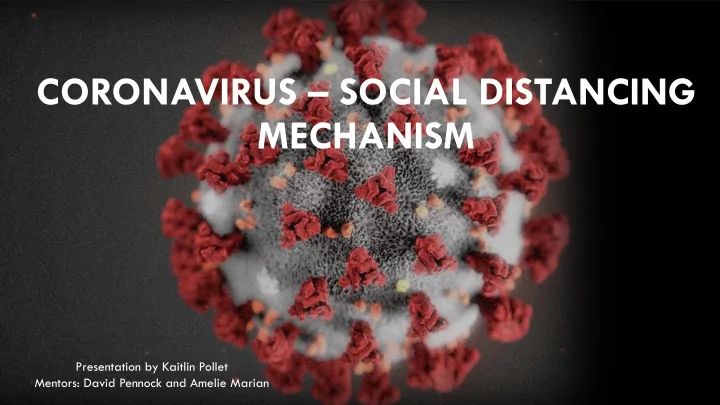

CORONAVIRUS – SOCIAL DISTANCING MECHANISM Presentation by Kaitlin Pollet Mentors: David Pennock and Amelie Marian
ORIGINAL IDEA: PARTITIONING INTO GROUPS – COLLEGE EXAMPLE In person class – Monday Dining Hall Assigned Times Group 1 Lunch - 11:30-12 Dinner - 5-5:30 In person class – Tuesday Dining Hall Assigned Times Group 2 Lunch – 12-12:30 Dinner - 5:30-6:00 In person class – Wednesday Dining Hall Assigned Times Group 3 Lunch - 12:30-1 Dinner - 6-6:30 In person class – Thursday Dining Hall Assigned Times Group 4 Lunch - 1:00-1:30 Dinner – 6:30-7:00
REPRESENTING VIRUS SPREAD ON A GRAPH • Node – person • Edge – connection/social interaction
RELATED CONCEPTS • Percolation Theory • Graphical Congestion Game • Correlated Equilibrium
GRAPH 1 - RANDOM • Random Grouping & Graph • Fairness • But different relationships have different weights
GRAPH 2 – RANDOM WITH WEIGHTS • Assigning random weights to edges (define by number of times a person sees another in a given period of time) • Remove edges of weight less than a given value • Partition into groups from here (randomly or keeping removing higher weight level)
CONNECTED CAVEMAN GRAPH Idea: fits with partitioning people into groups but has realistic quality that cheating would be involved
SIMULATION - TESTING • 120 nodes • 10 groups of 12 versus 12 groups of 10 • 8 groups of 15 versus 15 groups of 8 • 10% group & 30% group
Different Group Sizes 45 40 35 Number of Nodes Infected 30 25 20 15 10 5 0 1 2 3 4 5 6 7 8 9 Simulation Round 8 in a group 15 in a group 12 in a group 10 in a group
Differences between 1st node in 10% versus 30% 50 45 Number of Infected Nodes/People 40 35 30 25 20 15 10 5 1st node in 10% versus 30% at the end of simulation 0 1 2 3 4 5 6 7 8 9 50 Simulation Round 45 Group of 15 - 1st node in 10% Group of 15 - 1st node in 30% 40 Group of 8 - 1st node in 30% Group of 8 - 1st node in 10% Number of Nodes Infected Group of 12 - 1st node in 30% Group of 12 - 1st node in 10% 35 Group of 10 - 1st node in 30% Group of 10 - 1st node in 10% 30 25 20 15 10 5 0 0 2 4 6 8 10 12 14 16 Group Size 10% 30%
BALANCING GAME - UTILITY Is it worth seeing my friend to possibly get sick? Is it worth seeing my aunt to possibly spread the virus? Is it worth going to the store if I am immunocompromised?
Health versus Social Utility 1.4 1.2 Group of 15 Group of 12 1 Group of 10 Group of 8 0.8 Social Utility 0.6 0.4 0.2 0 0 20 40 60 80 100 120 Health Utility
ACKNOWLEDGEMENTS • DIMACS REU Program • NSF Grant CCF-1852215 • Mentors: David Pennock and Amelie Marian
REFERENCES connected_caveman_graph — NetworkX 1.10 documentation . Networkx.github.io. (2015). Retrieved 16 July 2020, from https://networkx.github.io/documentation/networkx- 1.10/reference/generated/networkx.generators.community.connected_caveman_graph.html. Duminil-Copin, H. (2017). Sixty Years of Percolation [Ebook]. Retrieved 16 July 2020, from https://arxiv.org/pdf/1712.04651.pdf. Game Theory Online. (2012). GTO-3-05: Correlated Equilibrium: Intuition [Video]. Retrieved 16 July 2020, from https://www.youtube.com/watch?v=sQOrIpARr5E. Southwell, R. (2012). Graphical Congestion Games [Video]. Retrieved 16 July 2020, from https://www.youtube.com/watch?v=NtwtNawqzN4.
Recommend
More recommend